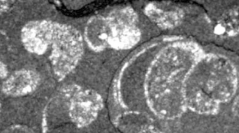

 Comptes Rendus Palevol
4 (6-7) - Pages 543-552
Comptes Rendus Palevol
4 (6-7) - Pages 543-552Microgastropod-dominated shell beds formed during the aftermath of the end-Permian mass extinction comprise a characteristic Early Triassic biofacies. The identification of this biofacies is significant: (1) no other episode in the geologic record is characterized by the lack of larger gastropods and abundant, conspicuous microgastropod-dominated shell beds; (2) its distribution indicates that the recovery from the end-Permian mass extinction was regionally variable and began sooner than previously interpreted. Occurrence of this biofacies supports the contention that chemically and/or physiologically harsh environmental conditions related to the cause of the end-Permian mass extinction were prolonged through much of the Early Triassic.
Microgastropods, Early Triassic, end-Permian mass extinction, biotic recovery, biofacies, opportunism